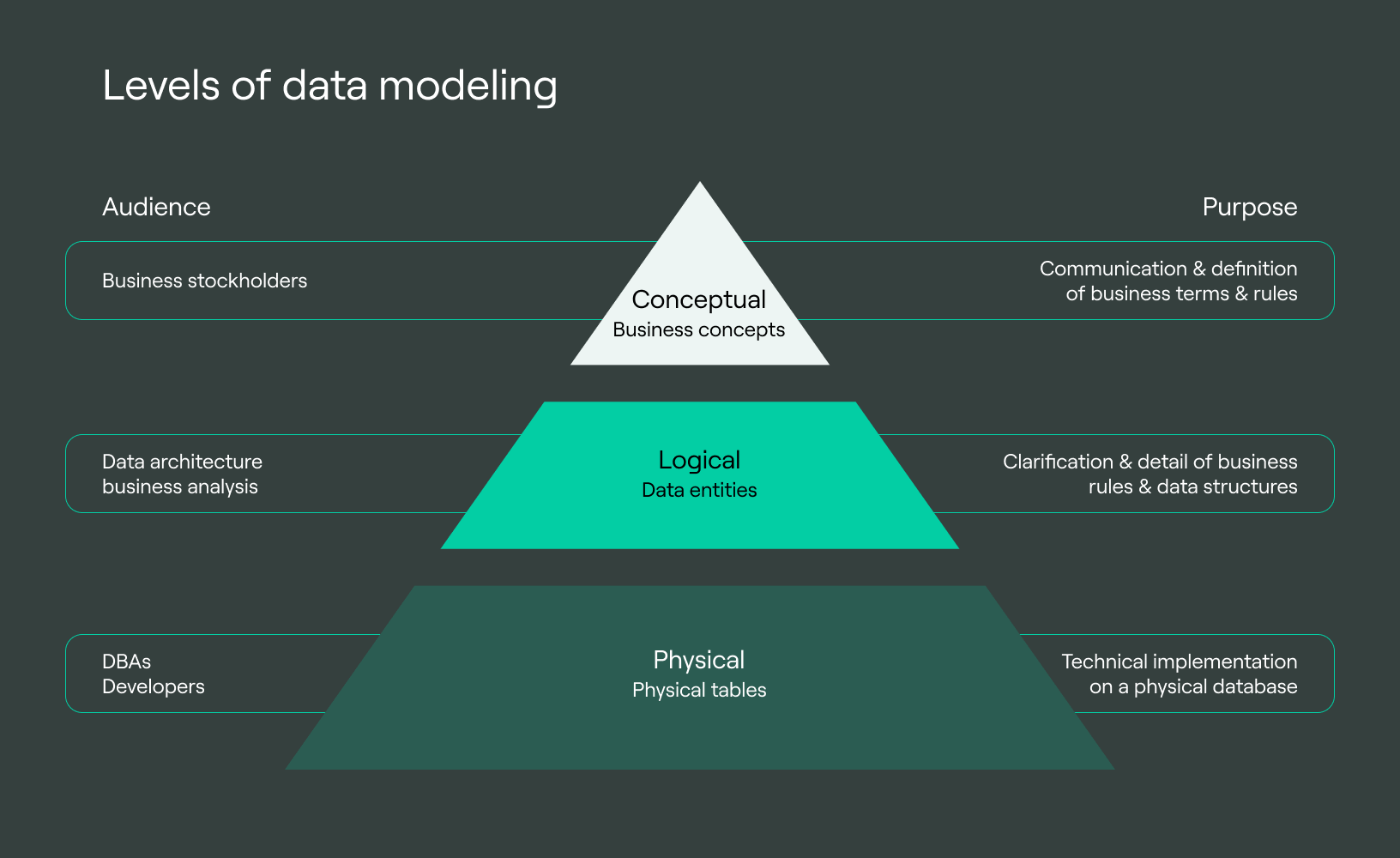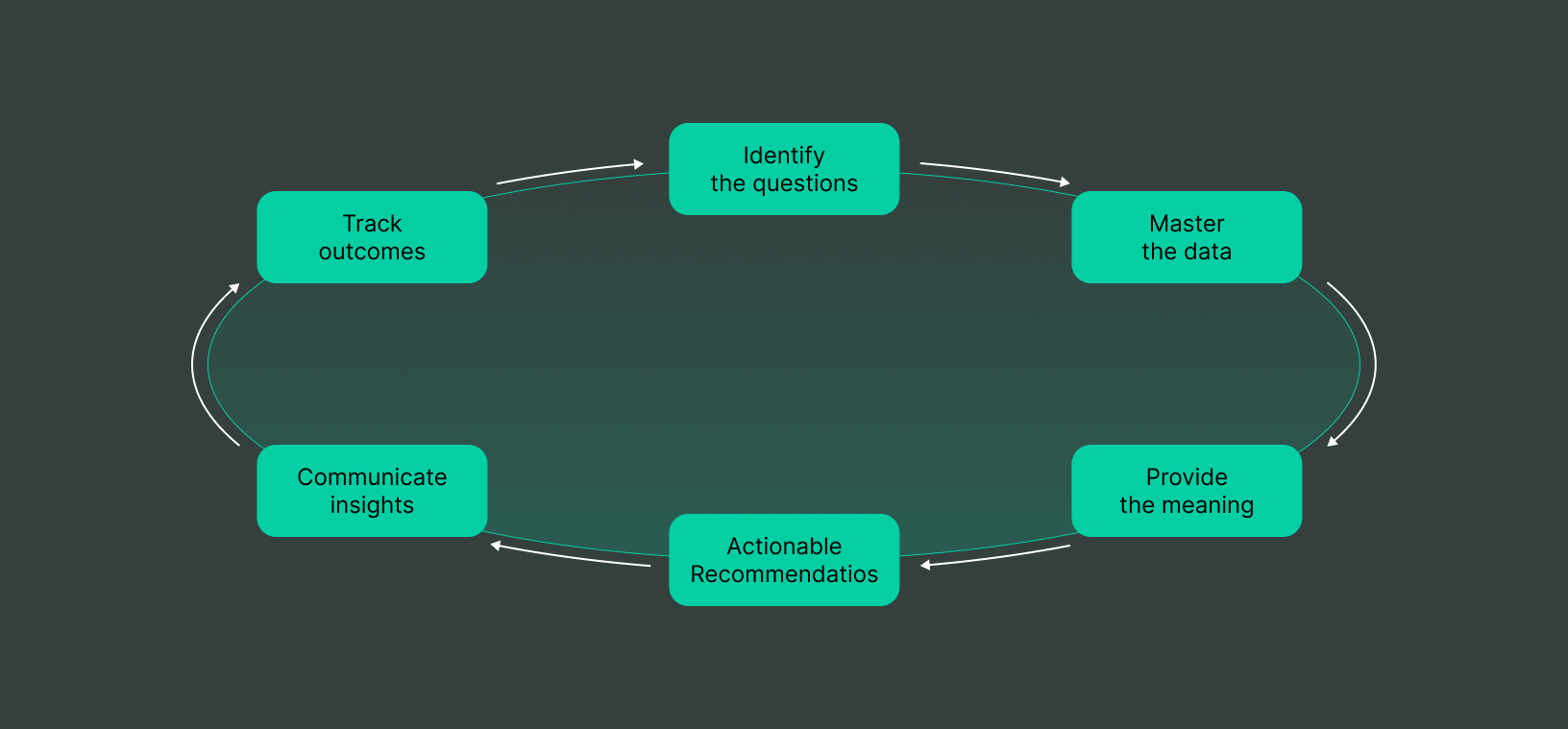
What is data modeling? Exploring the fundamentals
Data modeling involves creating a visual representation of data structures to establish a traceable relationship within a system. Organizations looking to define logical, conceptual, and physical data models use this concept to put together an approach to understanding their business goals, data elements, and processing needs. If your business needs a database that aligns with your objectives, this article provides information on how your data architects can implement graphs and relational or object-oriented data models for efficient data management and governance.

In this article, we’ll talk about:
- What is data modeling? meaning & definition
- Why is data modeling important?
- How data modeling impacts analytics?
- How data modeling helps in making business decisions?
- Types of data models
- Types of data modeling
- Benefits of data modeling
- Challenges of data modeling
- Data modeling process: required steps
- How doublecloud helps with data modeling?
- Final words
What is data modeling? Meaning & definition
Data modeling is an essential aspect of data management that enables organizations to better understand their data structures. By leveraging data modeling techniques, database owners can gain insights on complex data relationships and dependencies while making informed business decisions. Data modeling is also important in database design as it ensures the business upholds data integrity, structural alignment, and storage efficiency requirements.
Data modeling examples
Data modeling serves various purposes in different industries and below we will explore some examples of its applications.
-
E-commerce optimization: Dimensional modeling techniques can be utilized by e-commerce businesses to analyze customer behavior, identify trends, and optimize their product offers for better sales.
-
Healthcare analytics: Through logical data models, healthcare providers can seamlessly aggregate patient data, medical records, procedures, and treatments for better patient care.
-
Financial risk assessment: Assessing risk through quality risk management strategies is important to financial institutions and conceptual data models can help make it possible through seamless analysis of market data, customer credit profiles, and transaction patterns which also facilitates prudent decision-making.
Why is data modeling important?
In the field of data management and governance, data modeling is a critical process that guides organizations on how to structure and understand their data. Having a visual representation of data assets, no matter how complex they are, creates an adequate foundation for efficient database design and structure. It also enables businesses to streamline data processing efforts while optimizing decision-making and improving the business’s ability to identify insights and develop strategies from raw data.
Additionally, data modeling plays an important role in data integrity, data analytics, and data governance, which makes it an indispensable process for businesses looking to thrive in today’s data-driven landscape.
How data modeling impacts analytics?

Data modeling plays a pivotal role in ensuring the effectiveness of data analytics through logical and conceptual data modeling. It allows businesses to gain a deep understanding of their data assets through solid and insightful analytics. With effective data modeling powered by logical data models, businesses can align their storage database with their analytics requirements and unlock efficient data processing and retrieval capabilities.
Since data models provide a comprehensive visual representation of data, they simplify analytics, allowing business analysts to extract and deliver useful insights. This accuracy and reliability of data in turn fosters better decision-making and drives business success.
How data modeling helps in making business decisions?
With data modeling, businesses can gain clarity and valuable insights through conceptual, logical, and physical models. The importance of data modeling concept for improved business decision-making can be seen across various industries.
In the retail industry, customer data and purchasing patterns can be used to create a conceptual model for identifying in-demand products, optimizing promotions and enhancing overall customer experience.
Likewise in the healthcare management industry, patient records, medical procedures and treatment outcomes play an important role in the quality of patient care. If healthcare providers can implement logical data modeling and use the available data, they can seamlessly streamline medical operations and optimize care delivery.
Types of data models
Here are the three main types of data models and how they can be applied in ensuring a cohesive approach to effective data management.
Conceptual data models
The key step in the data modeling process is conceptual data modeling, where the emphasis is on comprehending the fundamental business concepts and data requirements. It entails developing an abstract, high-level representation of data entities, attributes, and relationships.
Conceptual data models give business stakeholders and data architects a clear picture of the data structure through visual representation. Understanding business rules, defining data elements, and locating data entities important to the organization’s fundamental operations are all made easier as a result.
Conceptual data modeling establishes the logical and physical data models and ensures that the data is in line with business goals. It also paves the way for effective database design and data management.
Logical data models
A critical step in the data modeling process is logical data modeling, which focuses on converting the conceptual data model’s abstract concepts into a usable and organized representation. Making sure the data comply with business requirements entails defining data entities, attributes, and their relationships.
Logical data models enable a deeper understanding of intricate data relationships, business rules, and data storage through a visual representation. Data architects can create an effective and optimized database system by using them as a link between the conceptual model and the actual database structure.
Furthermore, physical data models are built on logical data modeling, which is also essential for database design, data management, and storage.
Physical data models
Physical data modeling translates abstract ideas into a concrete database structure and serves as the practical application of logical data modeling. It outlines the precise data types, storage mechanisms, and access techniques needed for the best possible data processing and retrieval.
Physical data models help data architects design a reliable and effective database system by visualizing the actual database structure. It covers implementation details that align with the logical data model, including database management systems, data structures, and the data itself.
This type of data modeling also supports data governance, ensures data integrity, and simplifies data storage. It serves as the foundation for database design and enables companies to efficiently store, manage, and use their priceless data assets.
Types of data modeling
Here are some methods applied when modeling data to meet business requirements.
Hierarchical data modeling
Hierarchical data modeling is a data organization approach where data is structured in a top-to-bottom parent-child relationship. In order to form a hierarchical representation, it entails building a tree-like structure with parent nodes connected to numerous child nodes.
Since there can only be one parent for each child node in this model, a simple and straightforward data flow is guaranteed. In systems like file systems and XML, where data elements have a distinct hierarchical structure, hierarchical data modeling is frequently used.
This method is useful for some types of data relationships because it makes data access, retrieval, and management easier. However, it might not be appropriate for displaying the intricate data connections present in relational data models.
Network data modeling
Network data modeling is a dynamic approach that is focused on capturing and representing complex data relationships in interconnected structures. Network data modeling, in contrast to conventional data models, allows entities to have multiple relationships, enabling more complex and adaptable data representations.
Data dependencies are clearly depicted in network data models, where data entities are linked together by nodes and edges to form a web-like structure. Businesses can better comprehend the information flow and interactions between data elements thanks to this visual representation.
For situations with complex data relationships, like social networks, supply chain management, and hierarchical data structures, network data modeling is especially helpful. Network data modeling empowers businesses to gain insights, optimize processes, and make wise decisions based on the underlying data dynamics by embracing interconnectedness.
Relational data modeling
A key component of database design is relational data modeling, which focuses on creating relationships between data entities. Here, data is arranged into tables using a relational data model, with each row denoting a particular record and each column containing pertinent data attributes.
Relational data modeling makes it easier to retrieve, update, and maintain data by building logical data models based on relationships and dependencies. It guarantees data accuracy and integrity by using primary and foreign keys.
Relational databases frequently use relational data modeling because it provides flexibility, scalability, and simple data manipulation. It serves as the foundation for many applications, assisting companies in efficiently managing their data and gaining insightful information.
Entity-relationship data modeling
Entity-Relationship (ER) data modeling is a powerful technique that helps in understanding and representing complex data relationships. It concisely and clearly illustrates the relationships between entities (objects, people, or concepts) through the use of visuals.
Entities are depicted in ER data modeling as rectangles, and relationships are shown as lines connecting these entities. The model displays cardinality, which denotes how many instances there are of each entity.
Because it makes the representation of data structures, business rules, and storage needs simpler, ER data modeling is essential for database design. With ER, businesses can easily make informed decisions and streamline their data management procedures due to the visual representation of data entities and the relationships provided.
Benefits of data modeling
Improved data quality and accuracy
Data modeling makes sure that data is accurately defined and structured, improving the quality and accuracy of the data. Businesses can find and fix discrepancies or errors in data sources by developing logical and physical data models, thereby ensuring reliable insights for decision-makers.
Enhanced ability to analyze complex data sets
The visual representation of intricate data dependencies and relationships is made simpler by data modeling. Physical data models optimize data storage for effective analysis of large datasets, while logical data models allow businesses to comprehend data elements and their interactions.
Facilitation of data visualization and reporting
Data modeling makes it simpler for business stakeholders to understand and interpret data by allowing for the visual representation of data entities and their relationships. This is how businesses are able to produce insightful data visualizations and reports using well-defined data models, facilitating better understanding and communication of critical information.
Increased efficiency and scalability of data analytics processes
Data modeling increases the effectiveness of data analytics processes by streamlining data storage and processing. It guarantees that database designers will take scalability into consideration when creating databases, allowing businesses to handle growing data volumes and support the expansion of data-driven initiatives.
Challenges of data modeling
-
Complexity: Data modeling involves dealing with complex data structures with intricate relationships, especially in large-scale enterprises. The complex data hierarchies and interdependencies can sometimes make the accuracy and efficiency of data models very challenging.
-
Ambiguity: Gathering data modelling requirements from various stakeholders can result in ambiguous or conflicting information, making it difficult to define clear and consistent data models.
-
Data Quality: The reason data integrity is necessary for data modeling is because it heavily relies on the quality of data being modeled. Poor data quality, such as missing or inaccurate insights, can lead to flawed data models and erroneous information.
-
Change Management: To meet up with the dynamics of business, data models must adapt quickly and accordingly. However, managing and updating data models to reflect new and emerging business needs can be complex and time-consuming.
-
Lack of Standardization: Inconsistent data modeling practices across different teams or departments in an organization can hinder efficient data integration and lead to accumulation of data silos.
-
Communication: Effective communication between data modelers and stakeholders is vital for understanding and aligning data structure with business requirements and objectives.
-
Scalability: As data volumes increase, data models need to be scalable to accommodate growing datasets and evolving data storage requirements.
-
Resource Constraints: Limited resources, such as time and team expertise can impact the depth and accuracy of data models.
Data modeling process: Required Steps
Identify the problem or question to be addressed:
Commence by understanding the particular business problem or inquiry that demands data analysis. Precisely define the objectives and scope of the data modeling process.
Gather and explore relevant data sources:
Accumulate data from diverse sources, including databases, spreadsheets, APIs, and more. Investigate the data to comprehend its structure, quality, and potential insights.
Develop a conceptual data model:
Craft a high-level conceptual data model depicting the primary entities and their relationships. This abstract model visually represents the essential data elements and their associations.
Create a logical data model:
Translate the conceptual model into a logical data model. Define the entities, attributes, and relationships using standardized approaches, without considering a specific database implementation.
Design a physical data model:
Devise the physical data model to implement the logical model within a specific database management system. Specify data structures, data types, primary and foreign keys, and data storage mechanisms.
Implement and test the data model:
Lastly, put the physical data model into action in the chosen database system. Thoroughly test the data model to ensure accuracy, efficiency, and effectiveness in addressing the initial issue or inquiry.
How DoubleCloud helps with data modeling?
Since data modeling involves creating a visual representation of datasets, innovative data visualization tools are needed to gain insights and draw accurate conclusions from your data. DoubleCloud’s AI-powered data visualization tool has built-in features that allow businesses to take advantage of data insights without the cumbersome work of manual data analysis and review.
With DoubleCloud’s visualization tool, you get ready-made summary and useful conclusions from your data and charts. The various connectors like Clickhouse, PostgreSQL, MySQL and others available on DoubleCloud means users will have no issues creating and configuring their dashboards to pull together insights from different data sources.
Final words
In summary, data modeling is a crucial concept for companies and other organizations looking to harness the power of data-driven insights. Data modeling opens up many possibilities for data analysis and decision-making through a methodical process of conceptualization, logical structuring, and physical implementation.
Additionally, data governance is crucial to the accomplishment of data modeling projects. Setting up solid data governance procedures ensures data security, compliance, and accuracy, fostering a reliable basis for business analytics.
As a final thought and recommendation, we urge businesses to prioritize data modeling and make investments in data governance. By doing this, they can increase their capacity for decision-making, gain access to insightful information, and maintain an edge in today’s the fiercely competitive environment. Businesses can confidently steer towards a better, data-driven future with the help of data modeling.

DoubleCloud Visualization. Get insights with ChatGPT!
Don’t waste time reading numerous reports and manually analyzing data — rely on AI-Insights and get fast and accurate conclusions.
Frequently asked questions (FAQ)
What is the purpose of data modeling?
What is the purpose of data modeling?
In order for businesses and organizations to fully understand, examine, and make informed decisions based on their data assets, data modeling is needed to create a structured and organized representation of data. It facilitates effective data storage and retrieval processes by ensuring data integrity and establishing clear relationships between data elements.
Why is data modeling important?
Why is data modeling important?
What are some best practices for data modeling?
What are some best practices for data modeling?
Start your trial today



